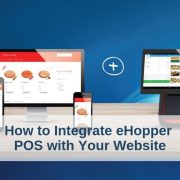How To Open An Online Store For Your Shop
Change is good. Isn’t that how the saying goes? And if you own a small business, you are well aware of the fact that your business needs to change with the times. And, now is the time that small businesses enter the world of e-commerce. The truth is, businesses with online stores experience as much as 30% increased sales.
That’s because when you create an online store for your local shop, it allows people from all over the world to find and shop with your company, which means you’re no longer exclusively restricted to the foot traffic and consumers in your immediate area.
Some local businesses resist the allure of creating an online store because they fear that it will harm their image as a small, neighborly business.
In reality, many local customers wish more of their favorite shops and small businesses had online shops.Why? Customers know that if they love these products, then their friends in other areas likely will too. The online store makes it easy for them to introduce their out-of-town friends to their favorite in-town shop.
When a small business online store is done right, it can yield significant returns and create a new extension to your already-great shop. The benefits are a two-way street. Shopping online offers convenience for customers (both new and old) and fresh market opportunities for you and your products.
This discussion will look at the necessary steps for opening an online store for your shop. Most of these steps are easy to complete, while others may require you to enlist the help of a web development or small business eCommerce solution.
Step #1: Register Your Domain
If you have an existing website, you may have already done this step, for the most part. Registering an easy-to-remember domain is an essential step for your online store because it makes it simple for customers to find.
If you’re attaching an online store onto an existing small business website, you want to make sure that your store has a convenient URL tag. In an example, “www.yourstore.com/store.”

Register an easy-to-remember domain
Step #2: Set Up Business Email Address
Depending on how your small business website is set up, you may already have a business email address connected to your site. Alternatively, you may have the option and not be aware or just choosing to keep an existing email address.
While migrating your emails can be a time-consuming task and short-term annoyance, your business indeed appears more professional when you have a business email address. Simply put, customers are going to trust John@yourbusiness.com more than they will John@Yahoo.com.
Not to mention, once you get used to using a business email address, you’ll realize how organizationally beneficial it is to keep your private and business emails separated.

Set up business email address. Customers are going to trust John@yourbusiness.com more than they will John@Yahoo.com.
Step #3: Draft Privacy, Terms Of Use and Return Policy
You have to govern your online store with rules and policies, just as your physical shop is run. It is essential to have your return policy and other relevant information available to customers on your online store.
Unlike your physical shop, where a customer can ask you or an employee a question, online stores have to leave nothing up to question and include all of the info that any customer could want or need to have a successful online shopping experience.
Online stores also have to include details in their privacy policies about how they handle customer information and data. This is increasingly becoming a mandatory practice for online stores, as data breaches and stolen customer info becomes a more prevalent issue.
If your site has an existing privacy policy, make sure it includes details on your consumer data privacy practices and that your online store is compliant with the latest federal regulations regarding Internet businesses and data collection.
Step #4: SSL Certification
On the topic of security and customer data, it’s also crucial that you update your site with the latest Internet security protocol. Secure Sockets Layer, Or SSL (the ‘S’ in HTTPS), is becoming a must-have for any small business website, especially those with an eCommerce platform built in.
In fact, 84% of users stated that they would abandon a purchase from an online store if the connection or transaction were insecure. This security layer helps to ensure that every transaction or exchange of customer information is done so on a secure and encrypted channel.

SSL (the ‘S’ in HTTPS), is becoming a must-have for any small business website.
With all of these data breaches and security concerns, consumers are learning to keep an eye out for sites with SSL certifications. You may have even noticed this yourself, as a lot of the popular browsers display a locked padlock symbol for secure, SSL sites, with an unlocked padlock signaling an unsecured location.
If you are converting an existing small business website into an online store, you’ve likely never considered how secure your site is because there’s no exchange of sensitive information taking place. But, now that you’ll be generating sales and accepting payments, it’s essential to upgrade the site with this added layer of security.
Google has also routinely stated that secure websites receive a boost in SEO rankings.
Step #5: Select Your eCommerce Solution And Website
At the start of developing your online store, you have a huge decision to make, which is whether you’re going to handle your eCommerce business yourself (self-service) or use an outside hosting service for your online shop (hosted service). There’s advantages and disadvantages of each.
Self-Service: If you choose to handle your eCommerce in-house, you have a lot more control over the ordering process and the experience that guests or shoppers experience.
If you’re worried about disenchanting your local customer base by beginning to generate sales online, taking the self-service route may be a better option because you can cater your online experience to mirror how guests are treated in-store, whereas outsourcing your eCommerce solution to a third-party may create an experience that is disjointed from how your shop customers feel.
The drawback to self-service is that it is a lot more work; you have to complete orders, handle payments and solve customer complaints on your own.
Hosting Service: A lot of small business online stores opt to use a paid eCommerce solution because of the convenience they provide. Business owners can permanently set up their online store and then put the rest of the responsibilities and worries into the hands of their service provider.
This is an excellent avenue for business owners that already feel they have enough on their plate handling the physical store.
Once a hosted eCommerce store is created, there’s no real work to be done except to look at the sales numbers and occasionally update your product offerings with new items or information.
The biggest drawback to a hosting service is the loss of control, as discussed earlier, and the fees that many of these services assess. Hosting services will generally charge a cut of your sales as compensation for the use of their platform and resources.

Select your eCommerce solution, whether you’re going to handle your eCommerce business yourself (self-service) or use an outside hosting service (hosted service).
Step #6: Upload Your Products And Details
Similar to including information about your return policy and other pertinent business information, you should also go into great detail about each product. Every item you sell should consist of a picture of that product, a thorough description, a price and, if possible, videos of the product too.
The more details you’re able to share, the easier it is for consumers to answer all of their questions, conduct research, compare your offerings to competitors and so on. This is a critical step, with as many as 81% of consumers performing in-depth analysis into products before buying.
Your product descriptions also play an essential role in your online store’s SEO. You want your products and small business website to have a lot of visibility in searches, as this will help you generate sales from people that are not already aware of your company’s existence.
By optimizing your descriptions with a mix of high- and low-volume keywords, you can drastically enhance your site’s visibility in search ranking to generate more traffic, thereby creating more opportunities to convert that traffic into sales.
Step #7: Decide On A Payment Solution
This step is an important one for small businesses that are going the self-service route. Most hosted eCommerce solutions have the payment method that they’ll use. For self-service online stores, there’s a lot of different ways to accept online payments.
Some of the big companies are PayPal, Authorize.net, Stripe, and USAePay. Each payment solution has their pros and cons. Business owners should do the necessary homework in measuring what these advantages and disadvantages are and determine which solution works the best for the types of customers/sales that the business commonly handles.

Decide on a payment solution. Some of the big companies are PayPal, Authorize.net, Stripe, and USAePay.
For example, some payment solutions are better geared towards frequent, small purchases. Others may offer better rates on significant investments. You also have to consider any service charges and how often payments are deposited into the business’ account.
Some services will collect each transaction as they come in, while another solution may have a dollar threshold, which means money will only be transferred after that threshold is met, like every $100 in sales or $500.
Step #8: Integrate Your Shop’s POS System With The Online Store
When you supplement your brick-and-mortar shop with an eCommerce store, inventory management can become a nightmare, unless you integrate your shop’s POS system with your small business online store.
Otherwise, you could find yourself entangled in issues where your site thought there was stock of an item left, when a customer in-store purchased those items at the same time, or vice versa.

Integrate your shop’s POS system with your small business online store.
Customers will quickly become unhappy with your business’ service if they have to wait weeks for their online order to be completed and arrive at their doorstep because you had to wait for the items to come from your distributor.
Conversely, nothing is worse for your in-store customers than making a special trip for an item, only to find out that there is none left in stock.
This step is dependant on your store’s POS system and its provider. If you use dated POS software, it may be time to update, as it may not be incapable of blending your online and physical store sales. Luckily, the cost of a modern POS system is not as expensive as it once was.
Many of today’s mobile POS systems, like eHopper, are relatively inexpensive and use cheaper hardware and software (often with better features) for an all-around better experience, both customer and business alike.
Step #9: Market Your Online Store
Once you’ve completed all of the prior steps, your online store is finished. Your products have rich descriptions, your site is secure and ready to accept payments, inventory is integrated with your physical store, and you have a convenient web address to point customers towards.

Market your online store and notify new and old customers of its existence.
Now, it is time to begin marketing your online store and notifying new and old customers of its existence. There’s a lot of marketing tactics and channels that you can use to get the word out about your small business online store to generate buzz:
SEO: If you’ve taken the time to write up detailed, keyword-optimized product descriptions and secured your site with an SSL certificate, then you’ve already created a good foundation for your SEO efforts. You can also develop meta tags/descriptions, create blog content, generate internal and external link structures and other SEO-focused tactics to give your site more authority and visibility in searches.
Social Media: If your store is active on social media channels, this is an excellent jumping off point for getting the word out about your online store. It helps alert your local customers that they can now browse your selection online. It’s also great for customers that visited your business on vacation or have since moved away because it signals that they can now make another purchase from out of town.
PPC: Through a service like Google Ads or Facebook Ads, you can pay to put an advertisement for your online store in front of targeted audiences that will find your products useful. This can be an excellent strategy for a new online store looking to begin generating customers and buzz instantly.
Email Marketing: In the same vein as social media, if your store has an email newsletter, this can also be an excellent platform to leverage to notify customers that you now sell your products online.
Advertise At Your Physical Store: When customers visit your store in person, you should make an effort to notify them that you also have an online store. You can use business cards with your new online store’s address, and email address listed, as well as create signage and other notifications to display in the store. While you don’t want to detract from the business that your physical store does, your online store can become a valuable resource to help your in-store customers.
Conclusions
Developing an online store is a daunting task, and many small business owners are hesitant to bring their business to the Internet.
However, when done correctly, a small business eCommerce store can not only be a new channel and source of sales, but it can also be a valuable resource for your local customers too, which may encourage them to make better-informed purchases at your shop.
If you’re interested in creating an online store that elevates your business and customer experience to the next level, we encourage you to contact us at support@eHopper.com for a free consultation.









Leave a Reply
Want to join the discussion?Feel free to contribute!